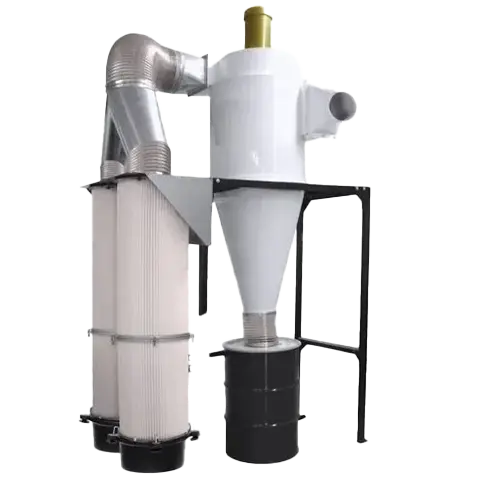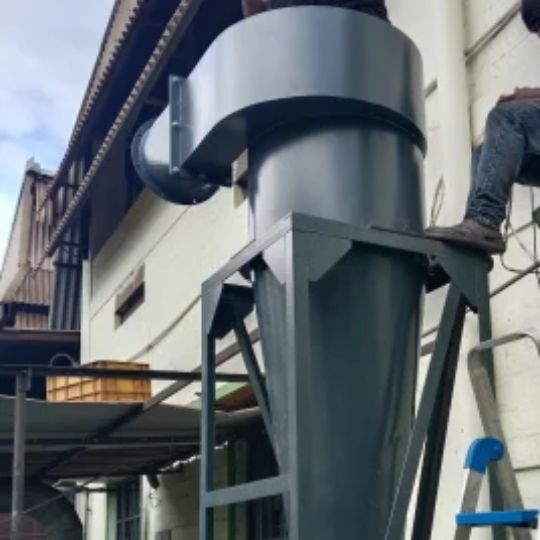Cyclone Dust Collector
Cyclone Dust Collector

Cyclone Dust Collector
In the industrial world, dust is an invisible yet relentless force—disrupting operations, compromising worker health, and threatening environmental compliance. D4S Industries® steps in with its advanced Cyclone Dust Collectors, engineered to tackle even the heaviest dust particles with unparalleled precision and efficiency.
The Science of Separation: Centrifugal Force at Work
D4S Industries® Cyclone Dust Collectors harness the power of centrifugal force, making them the ultimate solution for dust control. As dust-laden air enters the system, it is drawn into a swirling vortex. Heavier particles, unable to resist the centrifugal pull, are flung outward and spiral downwards into the strategically placed collection bin at the bottom. Meanwhile, the cleaner, lighter air rises effortlessly upwards. This precise process delivers:

-
Exceptional Capture Efficiency: The cyclone effectively captures even the most challenging dust particles, from metal filings to wood chips, ensuring minimal exposure.
-
Reduced Wear and Tear: The gentle separation process minimizes abrasion on system components, leading to longer equipment lifespan and reduced maintenance costs.
-
Environmental Responsibility: By significantly reducing dust emissions, D4S Industries® Cyclone Dust Collectors contribute to a cleaner, healthier work environment, supporting both compliance and sustainability goals.
Product Catalog
D4S Industries® Cyclone Dust Collectors are built for continuous 24/7 operation and are engineered to handle even the most challenging dust collection tasks. Explore our extensive product catalog, which showcases a wide variety of high-quality solutions to meet all your dust control needs.
Specification

Model
Motor capacity HP
Airflow (m3/hr)
Dimensions
(LBH) In mm
CS30
3
1950
0.9×1.0x2.4
CS50
5
2850
2.0×1.1×2.7
CS70
7.5
3500
2.1×1.2×3.1
CS100
10
4500
2.1×1.3×3.3
Features of Cyclone Dust Collector
- A tangential inlet for better cyclone effect
- Customization available
- Maintenance free blower
- Sturdy construction
- 24×7 continuous operation
- 1-year warranty
Application
- Pulp and paper plants
- Steel mills
- Metallurgical plants
- Cement plants
- Petroleum coke plants
- Saw mills etc.
Our Workflow?
Primary Separation with Dual Airflow
- Tangential Inlet: The dust-laden air enters the cyclone chamber tangentially, creating a spiraling motion.
- Main Airflow and Centrifugal Force: The main airflow spirals downward due to centrifugal force. This motion causes the heavier, coarser dust particles to be separated from the air stream.
- Coarse Dust Collection: The heavier particles settle to the bottom of the cyclone and fall directly into the collection bin or hopper positioned at the bottom of the cyclone.
Capturing Finer Dust Particles
- Secondary Airflow: At the bottom of the cyclone, a secondary airflow is created that moves upward in a central vortex.
- Fine Particle Capture: This inner airflow captures finer dust particles that were not separated in the primary stage, carrying them upwards to be filtered out.
Final Filtration and Collection
-
- Dust-Laden Air Exits the Cyclone: The air, now mostly free of coarse dust, exits the cyclone chamber through an outlet.
- Filter for Fine Particles: The exiting air passes through a filter system, which may include filter bags or other filtration media designed to capture any remaining fine dust particles.
- Collection Tank: A collection tank may be included to store the dust captured by the filter, preventing it from re-entering the air stream and ensuring cleaner air is released into the environment.
Take Control of Your Dust Management with D4S Industries
Ready to revolutionize your industrial dust control? D4S Reverse Pulse Jet Baghouse Dust Collectors offer cutting-edge solutions that combine efficiency, durability, and eco-friendly performance.
